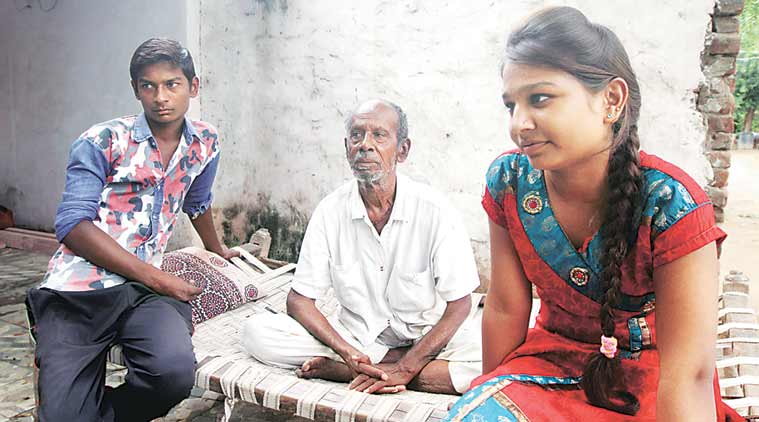- India
- International
Gujarat: 99% literacy in this village but separate garbas for upper castes and Dalits
Despite its high rate of literacy, Dagavadiya has its own shades of Una.
 Sanabhai Chamar with Sejal, who wants to be a Collector, and her brother Piyush in Dagavadiya. (Express Photo by Javed Raja)
Sanabhai Chamar with Sejal, who wants to be a Collector, and her brother Piyush in Dagavadiya. (Express Photo by Javed Raja)
Ashwin Chamar has an MA in Sanskrit and a second BA in Hindi, which he got in 2006. But he makes a living as a mason, after having failed to get a job. Dagavadiya village of Vijapur taluka has a 99 per cent literacy rate, much higher than Gujarat’s average of 79.31 per cent, but not many have jobs.
Three years ago, a fight between two boys, one from the OBC Chaudhary community and the other a Chamar from the Dalit community, led to stone-pelting and tension in the village. The 35 Chamar families here, who traditionally make a living out of skinning and disposing dead cattle, initially threatened to leave. But they reached a compromise with the Chaudharys because they could not afford to hire a vehicle and go to a Mehsana court for every hearing.
Today, the Dalits of Dagavadiya are disturbed by something that happened outside their village — the flogging of seven Dalits in Una by gau rakshaks for skinning dead cattle. “They were accused of gau hatya. The gau rakshaks took videos of the flogging and circulated it on WhatsApp as if they had won a war,” says Ashwin.
Despite its high rate of literacy, Dagavadiya has its own shades of Una. During the Navratri festival there are three garbas — one organised by the upper castes and OBCs, and two by Dalits.
Vijapur mamlatdar (revenue official) D B Tank, who had intervened to calm tensions in 2013, told The Indian Express, “The issue was mainly about Dalits not getting grocery from the store, the flour mills not giving them flour and a ban on entry into temples. I had gone there with the police and the social welfare department officials. We got the Senmas, the Chaudharys and the Chamars together to go to the Mahadev and Kali mata temples. Everything has been fine since then.”

Ashwin, however is cynical about this “compromise”. “You have been hungry all your life and one day someone gives you food, is that the way out? This is just a show on paper,” he says. According to him, the issue was not about entry to the temple, but about jobs and the fact that they don’t own land. He says he had to take up masonry to support his household as he failed to get a job even after attending many interviews.
But education does appear to have gone some way in giving Dalits a sense of empowerment. Official figures show that 99.7 per cent of men and 99.53 per cent of women in the village are literate. “If our girls say we want to study we don’t deter them, till they themselves say enough,” says Ashwin.
One of them is Sejal Kamleshbhai Chamar, 18, who has completed a BA from Visnagar town and is training in Information Technology from an ITI and wants to become a “collector”. “I am confident I will get a government job,” says Sejal, adding that her brother Piyush failed his Class X exams and joined the ITI to train as a welder.
The Senmas, who are originally basketweavers among Dalits, live in another part of the village and claim it was after the fight between the Chaudharys and Chamars that the mamlatdar visited the village to list them under MNREGA.
Watch Video: What’s making news
Bharatbhai Senma, 27, has a Bachelors in Rural Studies (BRS) and has been applying for jobs since 2009, but with no luck. “We don’t even come in the BPL category as we have APL cards,” he says.
The village, dominated by Chaudharys with 300 families, has about 25 Senma families, all of who are farm labourers. It has newly built toilets under the Swachhata Mission, though they have no water connection, yet. But all the Dalit communities say that there is no untouchability in schools and children sit together to study and eat.
While all of the Chamars are listed under MNREGA, they say they have not got any jobs this year. “We were engaged in relief work under MNREGA for three years before that, but the problem is wages take as long as six months to come,” says Sanabhai Chamar, a 60-year-old labourer.
All the Chamars still clear carcasses and complain that the Gujarat government has closed down tanneries. “Earlier, we used to earn Rs 200 per skin, but now the jobs have gone to the factories,” says Sanabhai. All of them sell cattle skin to a trader from the same community but another village.
In another part of the village, Becharbhai Chaudhary and his brother Vagjibhai, who are farmers owning 12 bighas of land each, feel the protests over discrimination were unwarranted. They live in a two-storey house built on their farmland and own Jersey cows and buffaloes. “It was never the case that they were not allowed into the temple. It was just a fight among the boys,” says Becharbhai.
But soon after those protests, says Ashwin, they were visited by Buddhists who urged them to convert to Buddhism.
“One of the monks told us you will get support from China and Japan if you convert. We put in applications to convert to Buddhism, but then sense prevailed. We were settled here and none of us wanted to leave. We thought over it and realised that we had done it in a fit of rage. We told them, all we wanted was support from the collector in the neighbourhood and not a foreign country,” he says.
Apr 26: Latest News
- 01
- 02
- 03
- 04
- 05







































